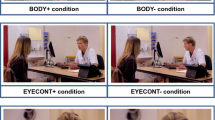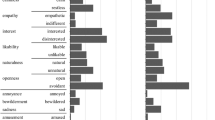Abstract
In this study, one particular form of nonverbal behavior—patient-directed gaze—was examined in relation to the general practitioner's performance in psychosocial care. Data were available from a random sample of 337 videotaped consultations and accompanying questionnaires from both general practitioner and patient. The relevance of general practitioners' gaze in psychosocial care was demonstrated in several ways: (1) general practitioners' gaze was associated with affective verbal behavior and with instrumental behavior on psychosocial topics; (2) general practitioners' gaze was related to patients' share of talking and the number of health problems presented, especially as regards psychological and social health problems; (3) in consultations with a relatively high degree of patient-directed gaze, general practitioners were found to be more aware of patients' psychosocial history and were better at identifying patients suffering mental distress. Patient-directed gaze appears to be a useful technique, both for decoding people's mental problems and for showing interest in the patient's story. This may encourage the patient to talk about worries that would otherwise remain concealed. In medical education, nonverbal techniques should be taught as distinct from verbal communication strategies.
Similar content being viewed by others
References
Argyle, M. (1978).The psychology of interpersonal behaviour, 3rd ed. Harmondsworth, Middlesex: Penguin Books Ltd.
Bensing, J. M. (1991a).Doctor-patient communication and the quality of care. An observation study into affective and instrumental behavior in general practice. Utrecht: Netherlands Institute of Primary Health Care.
Bensing, J. M. (1991b). Doctor-patient communication and the quality of care.Social Science & Medicine, 32, 1301–1310.
Bensing, J. M., & Dronkers, J. (1992). Instrumental and affective aspects of physician behavior,Medical Care, 30, 283–297.
Bensing, J. M., Bakker, D. de, & Brink-Muinen, A van den. (1993). Gender differences in practice style: A Dutch study of general practice.Medical Care, 31, 219–229.
Bensing, J. M., & Sluijs, E. M. (1985). Evaluation of an interview training course for general practitioners.Social Science & Medicine, 20, 733–744.
Bensing, J. M., & Verhaak, P. F. M. (1994). Psychische Problemen in de huisartspraktijk veelvormiger en diffuser dan in de psychiatricNederlands Tijdschrift Geneeskunde, 138, 130–135.
Bryk, A. S., & Raudenbusch, S. W. (1992).Hierarchical linear models: Applications and data analysis methods. Newbury Park, CA: Sage.
Carkhuff, R. R. (1969).Helping and human relations: A primer for lay and professional helpers. Vol. II. Practice and research. New York: Holt, Rinehart and Winston.
Cassell, E. J. (1991).The nature of suffering and the goals of medicine. New York: Oxford University Press.
Collier, G. (1985).Emotional expressions. Hillsdale, NJ: Erlbaum.
DiMatteo, M. R., Taranta, A., Friedman, H. S., & Prince, L. M. (1980). Predicting patient satisfaction from physicians' nonverbal communication skills.Medical Care, 18, 376–387.
DiMatteo, M. R., & DiNicola, D. D. (1982).Achieving patient compliance. The psychology of the medical practitioner's role. New York: Pergamon.
DiMatteo, M. R., Hays, R. D., & Prince, L. M. (1986). Relationship of physicians' nonverbal communication skill to patient satisfaction, appointment noncompliance, and physician workload.Health Psychology, 5, 581–594.
Engel, G. L. (1977). The need for a new medical model: A challenge for biomedicine.Science, 197, 129–136.
Engel, G. L. (1988). How much longer must medicine's science be bound by a seventeenth century world view? In K. L. White (Ed.),The task of medicine: Dialogue at Wickenburg. Menlo Park, CA: Henry J. Kaiser Family Foundation.
Foets, M., & Stockx, L. J. (submitted). The Dutch National Morbidity Survey of General Practice compared with national morbidity surveys in England and Wales.
Fridlund, A. J., Ekman, P., & Oster, H. (1987). Facial expression of emotion: A review of literature, 1970–1983. In A. Siegman & S. Feldstein (Eds.),Nonverbal behavior and communication (pp. 143–224). Hillsdale, NJ: Erlbaum.
Friedman, H. S. (1979). Nonverbal communication between patients and medical practitioners.Journal of Social Issues, 35, 82–99.
Gask, L., McGrath, G., Goldberg, D., & Millar, T. (1987). Improving the psychiatric skills of established general practitioners: Evaluation of group teaching.Medical Education, 21, 362–368.
Gezondheidsraad: Beraadsgroep Geneeskunde (Health Council). (1991).Medisch handelen op een tweesprong. The Hague: Gezondheidsraad.
Goldberg, D. P. (1972).The detection of psychiatric illness by questionnaire. London: Oxford University Press.
Goldberg, D. P., & Bridges, K. (1987). Screening for psychiatric illness in general practice: The GP versus the screening questionnaire.Journal of the Royal College of General Practitioners, 37, 15–18.
Goldberg, D. P., & Huxley, P. (1992).Common mental disorders: A biosocial model. London: Routledge.
Goldstein, H. (1987).Multilevel models in educational and social research. London: Griffin & Co.
Hall, J. A., Roter, D. L., & Rand, C. S. (1981). Communication of affect between patient and physician.Journal of Health and Social Behavior, 22, 18–30.
Hall, J. A., Roter, D. L., & Katz, N. R. (1988). Meta-analysis of correlates of provider behavior in medical encounters.Medical Care, 26, 657–675.
Hornsby, J. L., & Franklin, E. P. (1979). A model for communication skills: Development for family practice residents.Journal of Family Practice, 81–76.
Inui, T. S., & Carter, W. B. (1985). Problems and prospects for health services research on provider-patient communication.Medical Care, 23, 521–538.
Katon, W., Korff, M. von, Lin, E., Lipscomb, P., Russo, J., Wagner, E., & Polk, E. (1990). Distressed high utilizers of medical care. DSM-III-R diagnoses and treatment needs.General Hospital Psychiatry, 12, 355–362.
Kerlinger, F. N., & Pedhazur, E. J. (1973).Multiple regression in behavioral research. New York: Holt, Rinehart and Winston.
Lamberts, H., & Wood, M. (Eds.) (1987).The international classification of primary care (ICPC). Oxford: Oxford University Press.
Maes, S., Spielberger C. D., Defares, P. B., & Sarason, I. G. (Eds.) (1988).Topics in health psychology. Chichester: John Wiley & Sons.
Marks, J. N., Goldberg, D. P., & Hillier, V. F. (1979). Determinants of the ability of general practitioners to detect psychiatric illness.Psychological Medicine, 9, 337–353.
Ormel, J., Brink, W. van den, Koeter, M. J. J., Giel, R., Meer, K. vander, Willige, G. van de, & Wilmink, F. W. (1990). Recognition, management and outcome of psychological disorders in primary care: A naturalistic follow-up study.Psychological Medicine, 20, 909–923.
Pendleton, D. A., & Bochner, S. (Eds.) (1983).Doctor-patient communication. London: Academic Press.
Prosser, R., Rasbash, J., & Goldstein, H. (1991).Software for three-level analysis. London: Institute of Education, University of London.
Rogers, C. R. (1951).Client centered therapy. Boston: Houghton Mifflin.
Roter, D. L. (1989).The Roter method of interaction process analysis. Baltimore: Johns Hopkins University (unpublished manual).
Roter, D. L., & Hall, J. A. (1992).Doctors talking with patients/Patients talking with doctors: Improving communication in medical visits. Westport, CT: Auburn House.
Skuse, D., & Williams, P. (1984), Screening for psychiatric disorder in general practicePsychological Medicine, 14, 365–377.
Snedecor, G. W., & Cochran, W. G. (1980).Statistical methods. Ames, IA: The Iowa State University Press.
Strecher, V. J. (1983). Improving physician-patient interactions: A review.Patient Counselling and Health Education, 4, 129–136.
Truax, C. B., & Mitchell, K. M. (1971). Research on certain therapists interpersonal skills in relation to process and outcome. In A. Bergin & S. Garfield (Eds.),Handbook of psychotherapy and behavior, (pp. 299–344). New York: John Wiley & Sons.
Tuckett, D., & Williams, A. (1984). Approaches to the measurement of explanation and information-giving in medical consultations: A review of empirical studies.Social Science & Medicine, 18, 571–580.
Vasquez-Barquero, J. L., Diez Manrique, J. F., Gaite, L., Igleslias Garcia, C., Artal, J., Roberts, S. E., & Wilkinson, G. (1992). Why people with probable minor psychiatric morbidity consult a doctor.Psychological Medicine, 22, 495–502.
Verhaak, P. F. M. (1988). Detection of psychological complaints by general practitioners.Medical Care, 26, 1009–1020.
Verhaak, P. F. M., & Tijhuis, M. A. R. (1994). The somatizing patient in primary care,International Journal of Psychiatry in Medicine, 24, 163–183.
Waitzkin, H. (1985). Information-giving in medical care.Journal of Health and Social Behavior, 26, 81–101.
Waitzkin, K., & Britt, T. (1989). Changing the structure of medical discourse: Implications of cross-national comparisons.Journal of Health and Social Behavior, 30, 436–449.
White, K. L. (1988).The task of medicine: Dialogue at Wickenburg. Menlo Park, CA: The Henry Kaiser Foundation.
Wright, A. F., & Perini, A. F. (1987). Hidden psychiatric illness: Use of the General Health Questionnaire in general practice.Journal of the Royal College of General Practitioners, 37, 164–167.
Author information
Authors and Affiliations
Additional information
Thanks are extended to Glynn Coates, John F. Dovidio, and Robin DiMatteo for their comments as reviewers on the manuscript.
Rights and permissions
About this article
Cite this article
Bensing, J.M., Kerssens, J.J. & van der Pasch, M. Patient-directed gaze as a tool for discovering and handling psychosocial problems in general practice. J Nonverbal Behav 19, 223–242 (1995). https://doi.org/10.1007/BF02173082
Issue Date:
DOI: https://doi.org/10.1007/BF02173082




